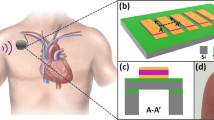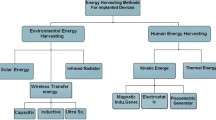Abstract
An implant of artificial cochlea is the only way how to recover lost hearing in some cases. Fully implantable artificial cochlea in comparison with recent approaches including partially implantable devices is proposed and discussed in this work. The proposed implant consists of subcircuits which are designed in close context to reach optimal performance and the lowest power consumption. Power consumption of the device is decreased to a value which allows designing the device as a zero-powered system using energy harvesting. A combination of micro-mechanized diaphragm filter bank, energy harvesting power source and especially ultra-low power processing electronics is presented in this article. A new technique of output signal generation for nerve stimulation is described. This new technique named charge push-through uses the major part of energy generated by energy harvesting subcircuit for output useful signal generation with minimal undesirable current. Thermal and mechanical parts were investigated using complex electro-mechanical simulations. The real energy harvesting power source (human motion, temperature) was experimentally measured. Signal processing circuits powered by energy harvesting power source were designed and simulated. The new signal processing circuits were simulated in relation to the results of complex electro mechanical diaphragm and SPICE energy harvesting power source simulation.














Similar content being viewed by others
References
Briggs RJS et al (2008) Initial clinical experience with a totally implantable cochlear implant research device. Otol Neurotol 29:114–119. doi:10.1097/MAO.0b013e31814b242f
Demosthenous A (2014) Advances in Microelectronics for Implantable Medical Devices. Adv Electron 2014:21. doi:10.1155/2014/981295
Dusek D, Hadas Z, Pekarek J, Svatos V, Zak J, Prasek J, Hubalek J (2015) Design of an artificial microelectromechanical cochlea. Solid State Phenom 220:345–348
Erismis MA (2013) Design and modeling of a new robust multi-mass coupled-resonator family with dynamic motion amplification. Microsyst Technol 19:1105–1110. doi:10.1007/s00542-012-1706-7
Fan-Gang Z, Rebscher S, Harrison W, Xiaoan S, Haihong F (2008) Cochlear implants: system design, integration, and evaluation. IEEE Rev Biomed Eng 1:115–142. doi:10.1109/RBME.2008.2008250
Frijns JM, Briaire J (2014) Auditory prosthesis. In: Jaeger D, Jung R (eds) Encyclopedia of computational neuroscience. Springer, New York, pp 1–6. doi:10.1007/978-1-4614-7320-6_554-1
Hadas Z, Ondrusek C, Singule V (2010) Power sensitivity of vibration energy harvester. Microsyst Technol 16:691–702. doi:10.1007/s00542-010-1046-4
Heat Capacity (2010) IT’IS Foundation. http://www.itis.ethz.ch/virtual-population/tissue-properties/database/heat-capacity/
Inaoka T et al (2011) Piezoelectric materials mimic the function of the cochlear sensory epithelium. Proc Natl Acad Sci 108:18390–18395. doi:10.1073/pnas.1110036108
Kim WD, Lee JH, Choi HS, Hur S, Park JS (2011) Design of a totally implantable artificial cochlea mimicking the human hearing mechanism. In: Han M-W, Lee J (eds) EKC 2010, vol 138. Springer Proceedings in Physics. Springer Berlin Heidelberg, pp 67–75. doi:10.1007/978-3-642-17913-6_9
Laizou PC (1999) Signal-processing techniques for cochlear implants. IEEE Eng Med Biol Mag 18:34–46. doi:10.1109/51.765187
Lan N, Nie KB, Gao SK, Zeng FG (2004) A novel speech-processing strategy incorporating tonal information for cochlear implants. IEEE Trans Biomed Eng 51:752–760. doi:10.1109/TBME.2004.826597
Lineykin S, Ben-Yaakov S (2007) Modeling and analysis of thermoelectric modules industry applications. IEEE Trans 43:505–512. doi:10.1109/TIA.2006.889813
Razzaghpour M, Golmakani A (2008) An ultra-low-voltage ultra-low-power OTA with improved gain-bandwidth product. In: Proceedings of ICM 2008, pp 39–42. doi:10.1109/ICM.2008.5393821
Rohr RV (2011) Cochlear Implant Impedance Telemetry Measurements and Model Calculations to Estimate Modiolar Currents., University of Zurich
Shintaku H, Nakagawa T, Kitagawa D, Tanujaya H, Kawano S, Ito J (2010) Development of piezoelectric acoustic sensor with frequency selectivity for artificial cochlea. Sens Actuators A 158:183–192. doi:10.1016/j.sna.2009.12.021
Svatos V, Pekarek J, Dusek D, Zak J, Hadas Z, Prasek J (2015) Design and fabrication of fully implantable MEMS Cochlea. Proc Eng 100:1224–1231. doi:10.1016/j.proeng.2015.01.487
Tognola G et al (2005) Measurement of electrode current pulses from cochlear implants. IEEE Trans Instrum Meas 54:2105–2112. doi:10.1109/TIM.2005.855120
Waltzman SB, Roland JT (2011) Cochlear Implants. Thieme, New York
Williams CB, Yates RB (1996) Analysis of a micro-electric generator for microsystems. Sens Actuators A 52:8–11. doi:10.1016/0924-4247(96)80118-X
Yawn R, Hunter JB, Sweeney AD, Bennett ML (2015) Cochlear implantation: a biomechanical prosthesis for hearing loss F1000Prime Rep 7(45):1–6. doi:10.12703/P7-45
Zak J, Hadas Z, Dusek D, Pekarek J, Svatos V, Janak L, Prasek J (2015) Design of the charge push-through electronics for fully implantable artificial cochlea. pp 95–180P-95180P-95189. doi:10.1117/12.2178987
Zak J, Hadas Z, Dusek D, Pekarek J, Svatos V, Janak L, Prasek J (2015) Model-based design of artificial zero power cochlear implant. Mechatronics. doi:10.1016/j.mechatronics.2015.04.018
Zeng FG, Popper AN, Fay RR (2004) Cochlear implants: auditory prostheses and electric hearing. Springer, New York
Acknowledgments
This paper has been supported by the project “A new types of electronic circuits and sensors for specific applications” No. FEKT-S-14-2,300 and by the National Sustainability Program under Grant LO1401. For the research, infrastructure of the SIX Center was used.
Author information
Authors and Affiliations
Corresponding author
Rights and permissions
About this article
Cite this article
Zak, J., Hadas, Z., Dusek, D. et al. The charge push-through electronics design for fully implantable artificial cochlea powered by energy harvesting technologies. Microsyst Technol 22, 1709–1719 (2016). https://doi.org/10.1007/s00542-016-2810-x
Received:
Accepted:
Published:
Issue Date:
DOI: https://doi.org/10.1007/s00542-016-2810-x




